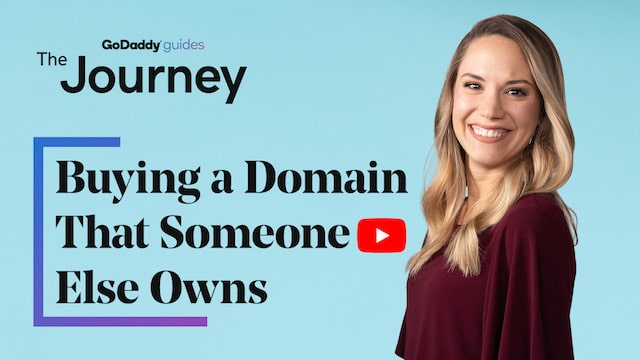How To Buy Existing Domain Name
This post was originally published on Nov. 23, 2015, and was updated on Nov. 12, 2018.
Maybe you've been here: You've got an amazing-with-a-capital-A business idea and you want to buy a domain name to go with it and start a new web empire. Or something like that.
Go ahead — start your domain search:
But what if your dream domain is taken? Somebody else has already registered it and, while you might see some great alternatives in the search results, you're bummed that "your name" isn't available. Egads! What can you do?
Related: Claim your domain and make a statement online
Where to buy a domain that's taken
From a branding and marketing perspective, it's especially important to choose the right domain name for your website. For many people, it's a truly personal decision. The domain just has to feel right — and you don't want to settle for an alternative.
If this is the case in your search for the perfect domain, take heart. You might be able to buy your ideal domain name in the domain aftermarket. You can find most of the domain names from the aftermarket listed directly on auctions.godaddy.com.
This is a great place to buy a domain that someone else already owns.
If your dream domain isn't listed on the aftermarket, you can attempt to buy it directly from its current owner. However, you'll want to keep a few things in mind before you take the plunge and contact the domain's owner, namely budget and timing.
Set your budget
It's important to think about the budget you have for acquiring the domain. Put yourself in the other domain owner's shoes for a minute. They spent time and money to get the domain, and they might be actively using it. Offering them $10 or even $100 probably won't even get you a response.
Don't take a bargain-basement approach. Prepare to make a fair offer.
Think about what the domain name is worth, and be prepared to make a fair offer.
Editor's note: Need help determining the value of the domain? As the largest reseller of aftermarket domain names, GoDaddy has access to extensive data that we use to analyze millions of historical domain sales. Try GoDaddy Domain Appraisals to determine the value of the domain so you can make an educated offer.
Related: GoDaddy Domain Appraisals — A new domain valuation tool
Give yourself enough time
 When you set out to buy a domain via the aftermarket the other key thing to keep in mind is timing. While it is possible to get in touch with the owner of the domain you want and get them to agree to sell it to you for the right price, it probably won't happen in a day. In most cases you should plan on a month to give yourself the time you need to contact the owner, negotiate a fair price, make the payment, and get the domain name moved to your account.
When you set out to buy a domain via the aftermarket the other key thing to keep in mind is timing. While it is possible to get in touch with the owner of the domain you want and get them to agree to sell it to you for the right price, it probably won't happen in a day. In most cases you should plan on a month to give yourself the time you need to contact the owner, negotiate a fair price, make the payment, and get the domain name moved to your account.
4 steps to your dream domain
Now that you are ready to take the plunge and go for that perfect domain for your project, let's look at a few final steps which will give you the best chance at walking away with that name. There are really only a few steps involved in buying a domain:
-
Find out who owns your dream domain.
-
Get contact info for the decision maker.
-
Start negotiating.
-
Pay for and transfer ownership of the domain.
Of course, you can apply variations and tactics to each step, but I am confident someone with little domain buying experience can make a decent go of getting the exact name they want if they follow the steps below.
1. Find out who owns your dream domain
The first step in buying a domain someone else owns is finding out who the other person is. You can do this by using WHOIS. This is like the white pages of a phone book. Many times the name, email and phone number of the person who owns the domain name is listed there.
The WHOIS directory is like the white pages of a phone book.
There are times, however, when the person uses a privacy service or the information is out of date. Privacy on the WHOIS acts like an unlisted phone number; it adds other information on the WHOIS to guard the owner's personal information. The privacy email information almost always forwards to the real owner's email address, so it is still possible to try and contact them through the private email listed in the WHOIS directory.
There is also a new law in Europe — the EU General Data Protection Regulation (GDPR) — that allows people to remain more or less anonymous on the WHOIS. You can still contact them if they have their domain name registered with GoDaddy by scrolling to the bottom of our WHOIS lookup and choosing the option to "Contact Domain Holder."
Related: A latecomer's guide to complying with the General Data Protection Regulation
2. Get contact info for the decision maker
Once you have the email contact, do some basic research to learn more about the domain's current owner. You want to get in touch with a decision maker. Chances are, if you email a company's website administrator, they will ignore you.
You'll have better luck if you can get in touch with the business owner or a domain investor.
If you can only find the general email box of a medium- or large-sized company, dig around some more for ways to contact the decision maker of the company about the domain.
3. Start negotiating
Now the fun part begins: negotiation. Negotiation is an art and a science, so it's in your best interest to read up on the topic in advance. A few good resources include:
- Harvard Business Review
- Domain Holdings
- Domain Sherpa
- Symbolics
Related: How to respond to 5 negotiation tactics to save the sale
Industry expert Braden Pollock offers up one great piece of domain negotiation advice: "He who names a price first loses." It is always better to start out asking if the name is for sale and, if so, what the seller would consider letting it go for.
4. Pay for and transfer ownership of the domain
Next, you'll need to pay for the domain and transfer its ownership. I cannot stress enough the importance of using a third party to facilitate this process. You want to feel protected when you are paying for the domain and actually walk away with the domain you worked so hard to obtain. The seller wants to know they can trust your payment.
GoDaddy offers a trusted aftermarket platform for transacting domain name sales. You can also use alternative services such as Escrow.com, which hold the money until the name is accepted and confirmed to be in the buyer's account, and clear the funds for the seller prior to authorizing the movement of the domain to the buyer.
Ready to buy a domain?
As with anything else in business, getting started is often the hardest part. But now that you know how, I encourage you to jump into buying the domain you always wanted. Even a "no" from the current owner doesn't mean you have to give up; situations change, so it's always a good idea to check back in from time to time to let your dream domain's owner know you're still interested.
Want an expert to handle it for you? If all this domain aftermarket stuff sounds too complex or if you just don't have the time to deal with it, consider turning to a professional service like GoDaddy's Domain Broker Service. A broker will contact the domain's current owner and negotiate for the domain on your behalf. Done and done.
How To Buy Existing Domain Name
Source: https://www.godaddy.com/garage/how-to-buy-a-domain-that-someone-else-owns/
Posted by: wilcherinizing.blogspot.com


0 Response to "How To Buy Existing Domain Name"
Post a Comment